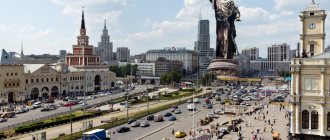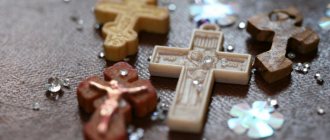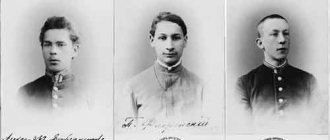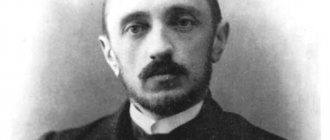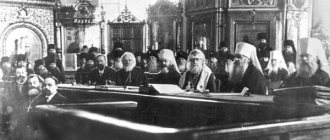For other uses, see Cowl (disambiguation).
St. Petersburg Theophan the Recluse wearing a hood. An Eastern Catholic Capital in a white hood. Cowl from Patriarch of Moscow Filaret (1619-33), Kremlin Museum
And the hood
is an item of monastic clothing worn by Eastern Orthodox and Eastern Catholic monks and bishops, especially in the Russian tradition. It consists of a kamilavka (a reinforced black headdress, round and flat on top) with an epanokamelavkion that completely covers the kamilavka and goes down over the shoulders and back.
In Athos, according to tradition, the epanokamelavkion is simply placed on the kamilavka and left hanging freely,[1] but in other traditions it is attached forever.[2]
A hood is a headdress that is most often worn in church by supposed monks. During the service, there are certain times when monks must remove their hood and place it on their left shoulder as a sign of honoring the sacred (for example, when the priest carries the Chalice through the Holy Door to distribute Holy Communion during the Divine Liturgy). Nuns usually do not remove their hood during services.[3]
Bishops often wear a hood. Diocesan bishops wear a simple monastic hood. Slavic Archbishops and Metropolitans usually wear small jewels crossed on the front of the hood as a sign of their rank.[4]Metropolitans wear a white hood, not black.[5]
The Patriarch of Romania wears a white hood as well as a white rason.[6] The Patriarchs of some Orthodox Churches (for example, the Patriarch of Moscow) wear a white headdress, similar to a hood, rounded at the top, decorated with an embroidered image of a seraphim, and crowned with a cross.[7]
Patriarchs and bishops of the Coptic Catholic[8] and Armenian Catholic[9] churches also wear a hood, although this is not the headdress worn by their Eastern Orthodox counterparts. Red hoods were worn by the Coptic Catholic patriarch,[10] the Armenian Catholic Catholicos,[11] and the Ukrainian Catholic chief archbishop[12] after being elevated to the cardinalate. The purple hood was used by the Catholic bishop of Ukraine.[13]
Recommendations
- The Athonite Typikon calls for the removal of the veil at certain moments during the service.
- The deacon's epanokamelavkion is usually removed because he only serves in kamilavka when he vests himself.
- Even when the nuns are supposed to be anointed on their foreheads, they do not remove their hood, but only put it on their heads so that the priest or bishop can anoint them.
- . 2006-02-22. Archived from on 2006-02-22. Received 2020-03-22. Missing or empty | title = (help)
- . 2005-05-02. Archived from on 2005-05-02. Received 2020-03-22. Missing or empty | title = (help)
- “Preoţi colaboratori ai fostei securităţi.” bbc.co.uk.
_ Received 2020-03-22.
. Missing or empty | title = (help)
. Missing or empty | title = (help)- "big5.jpg (358 x 450 pixels)." archive.is
. 2013-04-14. Received 2020-03-22. - . Missing or empty | title = (help)
- . 2004-04-15. Archived from on 2004-04-15. Received 2020-03-22. Missing or empty | title = (help)
- . 2007-01-28. Archived from on 2007-01-28. Received 2020-03-22. Missing or empty | title = (help)
- "Bishop Vasily Losten in a purple headdress." www.brama.com
. Received 2020-03-22.
What is different about the patriarch's hood?
The shape of today's hood was borrowed by the Russian church from the Greeks in the 17th century.
Since then, it has undergone almost no changes. In the modern interpretation, the doll is sewn from light material, it can be silk. In ancient times, the bedspread served as protection in bad weather and was made of thick fabric. The separated ends also had a practical purpose; they were used to tie the hood under the chin in bad weather. High-ranking monks wear a hood during church services and outside of it. Archbishops are prescribed black headdresses with diamond crosses sewn on them, framed in precious metal. The diamond cross symbolizes the strength of faith. The canon prescribing the wearing of diamond crosses on the kamilavka was approved at the end of the 18th century. Bishops are not allowed crosses on their hoods.
The Patriarch of All Rus' puts on a hood, different from others in shape and color. The Patriarchal Kamilavka has a white spherical shape with a diamond cross on the top. The frontal part is decorated with an icon; at the ends of the dome there are cherubs embroidered in gold. Metropolitans have a simple white hood with a cross. The right to wear white headdresses was granted to them in 1667.
The hood, especially the patriarchal one, resembles an ancient Russian helmet and is called in the church environment the “helmet of the hope of salvation.” This name comes from the words of the Apostle Paul: “Let us, being sons of the day, be sober, having put on the breastplate of faith and love and the helmet of the hope of salvation.”
The everyday vestments of priests and monks symbolize the qualities that all Christians should possess, who at Baptism were called soldiers of Christ.
Who are monks
From Greek, “monk” (μοναχός) is translated as “solitary, alone.” This means that a monk, in order to get closer to God and imitate the Savior’s lifestyle, moves away from the world. This is the fulfillment of the words of the Lord:
“And everyone who leaves houses, or brothers, or sisters, or father, or mother, or wife, or children, or lands, for My name’s sake will receive a hundredfold and will inherit eternal life” (Gospel of Matthew 19:29) .
Monasticism is a special gift of serving God.
The word “peace” in Orthodoxy has many meanings. It refers to human society, after the fall of the first people (Adam and Eve) focused on achieving only material, earthly goals. The world is the totality of sins and passions, as well as worldly values that contradict Christian teaching. The Orthodox understanding of removal from such a “world” is the desire to protect the soul and body from various temptations, seductions and sins that alienate a person from the Creator.
In 1 Corinthians (7:32), the Apostle Paul wrote:
“The unmarried man is concerned about the things of the Lord, how to please the Lord; but a married man cares about the things of this world, how to please his wife.”
Christians, who sought to completely devote their lives to the Lord, began to choose a virginal, that is, celibate, way of life. However, in the first centuries of Christianity this did not imply isolation from society. Then those who wanted to retire began to settle in deserts, caves, and forests. Hence the definition of monks as desert dwellers, hermits. The hermits lived in complete solitude for years, spending their days in work and prayer. The first of the hermits is considered to be the Monk Paul of Thebes (228-341). He lived for about 60 years in the Thebaid Desert (Egypt).
“As you know, only dead fish float downstream. And a monk is a person who has taken upon himself the feat of no less than confronting the world and the evil that exists in the world. This requires special internal strengths that need to be cultivated within yourself. And, of course, without God’s calling, without God’s deep blessing, without the grace that supports a person in this feat, it is impossible to be a monk” (hieromonk Sergius Rybko).
Clothes of a monk of the minor schema
In the small schema, a monk’s vestments consist of a tunic, a paraman, a cassock, a mantle, and a hood.
The tunic is part of the vestments of the monastics of the small and great schema. This is a garment made of coarse fabric that is worn under the cassock. The symbolic meaning is free poverty and non-covetousness.
Paraman is a square board on which a cross is depicted and the words of the Holy Apostle Paul are written:
“For I bear the marks of the Lord Jesus in my body” (Galatians 6:17).
The paraman is worn on the body under clothing using four cords. They are sewn at the corners so that a quadrangle is formed on the back, and a cross on the chest. The paraman is intended to remind the monk of the desire to follow Christ:
“If anyone wants to come after Me, let him deny himself, and take up his cross, and follow Me” (Gospel of Mark, 8:34).
On ceremonial occasions, the monk wears a robe, which is a long sleeveless cloak. For believers of the first centuries of Christianity, such clothes were worn by everyone who turned to the true faith and renounced the titles and ranks of the pagan world. This was a symbol of renunciation of idolatry, as well as an expression of humility. Over time, the mantle began to be worn only by monastics. Saint Germanus, Patriarch of Constantinople (634-733), interpreted the wearing of the mantle as a sign of angelic wings.
What is Orthodox monasticism
Monasticism as a separate type of Christian life took shape by the 4th century in Egypt. By this time, the first monastic communities began to appear. The Christians living in them lead a monastic way of life, that is, different from other believers. This difference lies both in internal changes (constant prayer, humility) and in external attributes. Such as a monk's robe.
It is common for every believer to think about his spiritual destiny. A Christian must independently choose the path to salvation. There cannot be the same path for everyone. Here the characteristics of each person, his vocation and spiritual strength must be taken into account. This can be a married life in a Christian marriage or a chaste, celibate life. Both paths are recognized by the Church as equally saving for man.
Orthodox monks
“God, who cares about our salvation, gave human life two kinds of direction, that is, marriage and virginity, so that those who are not able to endure the feat of virginity would enter into cohabitation with a wife” (St. Basil the Great, 330-379).
"Weapons" of the monks
For a truly monastic life, it is necessary to fulfill the prayer rule.
“The rule is the breathing of a monk, this is his daily meeting with the Lord and Teacher, Who Himself comes to visit him. The rule is the obligatory service of a monk, called to intercede with his prayer for the whole world” (Archimandrite Elijah Rago).
Since the time of the first Egyptian monks, the practice of constantly performing a prayer, called in Greek “monologistos” (a prayer consisting of one phrase), has been preserved. This is how the Jesus Prayer became widespread among monastics. It includes the name of the Savior and is usually associated with the publican's prayer:
“Be merciful to me, a sinner” (Gospel of Luke, 18:13).
The Holy Fathers said that constantly calling on the name of Jesus is the surest means of salvation and the only help and mercy of the one who prays.
In order to keep the mind focused on reading the Jesus Prayer, not to succumb to drowsiness and not to lose track of prayers, monks use rosaries. These are beads strung on a thread or knots (“grains”) tied on a dense thread. The ends of the thread are tied into a ring and crowned with a small cross. The most common number of knots on a rosary is 50 or 100. The cell rosary of monks sometimes contains 1000 of them. For fulfilling the monastic rule, which provides for hundreds of short prayers and bows, they are very convenient.
Monks receive rosaries when they are tonsured and therefore wearing them on their hands is natural. The holy elder Paisius the Svyatogorets (1924-1994) paid special attention to the monk’s prayer of the rosary:
“The rosary is a legacy, a blessing left to us by the holy fathers... Hold the rosary in your hands so as not to forget about the prayer that must be done internally in the heart. And when you leave your cell, remember that the enemy is ready to attack. Therefore, remember that a good soldier, leaving a trench, always holds a machine gun in his hands. The rosary has great power, it is the monk’s weapon, and the beads are bullets that mow down tangalasheks.”
Excerpt characterizing Klobuk
“Sit down, Natasha, maybe you’ll see him,” said Sonya. Natasha lit the candles and sat down. “I see someone with a mustache,” said Natasha, who saw her face. “Don’t laugh, young lady,” Dunyasha said. With the help of Sonya and the maid, Natasha found the position of the mirror; her face took on a serious expression and she fell silent. She sat for a long time, looking at the row of receding candles in the mirrors, assuming (based on the stories she had heard) that she would see the coffin, that she would see him, Prince Andrei, in this last, merging, vague square. But no matter how ready she was to mistake the slightest spot for the image of a person or a coffin, she saw nothing. She began to blink frequently and moved away from the mirror. - Why do others see, but I don’t see anything? - she said. - Well, sit down, Sonya; “Nowadays you definitely need it,” she said. – Only for me... I’m so scared today! Sonya sat down at the mirror, adjusted her position, and began to look. “They’ll definitely see Sofya Alexandrovna,” Dunyasha said in a whisper; - and you keep laughing. Sonya heard these words, and heard Natasha say in a whisper: “And I know what she will see; she saw last year too. For about three minutes everyone was silent. “Certainly!” Natasha whispered and didn’t finish... Suddenly Sonya moved away the mirror she was holding and covered her eyes with her hand. - Oh, Natasha! - she said. – Did you see it? Did you see it? What did you see? – Natasha screamed, holding up the mirror. Sonya didn’t see anything, she just wanted to blink her eyes and get up when she heard Natasha’s voice saying “definitely”... She didn’t want to deceive either Dunyasha or Natasha, and it was hard to sit. She herself did not know how or why a cry escaped her when she covered her eyes with her hand. – Did you see him? – Natasha asked, grabbing her hand. - Yes. Wait... I... saw him,” Sonya said involuntarily, not yet knowing who Natasha meant by the word “him”: him - Nikolai or him - Andrey. “But why shouldn’t I say what I saw? After all, others see! And who can convict me of what I saw or did not see? flashed through Sonya's head. “Yes, I saw him,” she said. - How? How? Is it standing or lying down? - No, I saw... Then there was nothing, suddenly I see that he is lying. – Andrey is lying down? He is sick? – Natasha asked, looking at her friend with fearful, stopped eyes. - No, on the contrary, - on the contrary, a cheerful face, and he turned to me - and at that moment as she spoke, it seemed to her that she saw what she was saying. - Well, then, Sonya?... - I didn’t notice something blue and red... - Sonya! when will he return? When I see him! My God, how I’m afraid for him and for myself, and for everything I’m afraid...” Natasha spoke, and without answering a word to Sonya’s consolations, she went to bed and long after the candle had been put out, with her eyes open, she lay motionless on the bed and looked at the frosty moonlight through the frozen windows. Soon after Christmas, Nikolai announced to his mother his love for Sonya and his firm decision to marry her. The Countess, who had long noticed what was happening between Sonya and Nikolai and was expecting this explanation, silently listened to his words and told her son that he could marry whomever he wanted; but that neither she nor his father would give him his blessing for such a marriage. For the first time, Nikolai felt that his mother was unhappy with him, that despite all her love for him, she would not give in to him. She, coldly and without looking at her son, sent for her husband; and when he arrived, the countess wanted to briefly and coldly tell him what was the matter in the presence of Nicholas, but she could not resist: she cried tears of frustration and left the room. The old count began to hesitantly admonish Nicholas and ask him to abandon his intention. Nicholas replied that he could not change his word, and the father, sighing and obviously embarrassed, very soon interrupted his speech and went to the countess. In all his clashes with his son, the count was never left with the consciousness of his guilt towards him for the breakdown of affairs, and therefore he could not be angry with his son for refusing to marry a rich bride and for choosing the dowryless Sonya - only in this case did he more vividly remember what, if things weren’t upset, it would be impossible to wish for a better wife for Nikolai than Sonya; and that only he and his Mitenka and his irresistible habits are to blame for the disorder of affairs. The father and mother no longer spoke about this matter with their son; but a few days after this, the countess called Sonya to her and with cruelty that neither one nor the other expected, the countess reproached her niece for luring her son and for ingratitude. Sonya, silently with downcast eyes, listened to the countess’s cruel words and did not understand what was required of her. She was ready to sacrifice everything for her benefactors. The thought of self-sacrifice was her favorite thought; but in this case she could not understand to whom and what she needed to sacrifice. She could not help but love the Countess and the entire Rostov family, but she also could not help but love Nikolai and not know that his happiness depended on this love. She was silent and sad and did not answer. Nikolai, as it seemed to him, could not bear this situation any longer and went to explain himself to his mother. Nikolai either begged his mother to forgive him and Sonya and agree to their marriage, or threatened his mother that if Sonya was persecuted, he would immediately marry her secretly. The countess, with a coldness that her son had never seen, answered him that he was of age, that Prince Andrei was marrying without his father’s consent, and that he could do the same, but that she would never recognize this intriguer as her daughter. Exploded by the word intriguer, Nikolai, raising his voice, told his mother that he never thought that she would force him to sell his feelings, and that if this was so, then this would be the last time he spoke... But he did not have time to say that decisive word, which, judging by the expression on his face, his mother was waiting in horror and which, perhaps, would forever remain a cruel memory between them. He did not have time to finish, because Natasha, with a pale and serious face, entered the room from the door where she had been eavesdropping. - Nikolinka, you are talking nonsense, shut up, shut up! I’m telling you, shut up!.. – she almost shouted to drown out his voice. “Mom, my dear, this is not at all because... my poor darling,” she turned to the mother, who, feeling on the verge of breaking, looked at her son with horror, but, due to stubbornness and enthusiasm for the struggle, did not want and could not give up. “Nikolinka, I’ll explain it to you, you go away - listen, mother dear,” she said to her mother. Her words were meaningless; but they achieved the result she was striving for. The countess, sobbing heavily, hid her face in her daughter's chest, and Nikolai stood up, grabbed his head and left the room. Natasha took up the matter of reconciliation and brought it to the point that Nikolai received a promise from his mother that Sonya would not be oppressed, and he himself made a promise that he would not do anything secretly from his parents. With the firm intention, having settled his affairs in the regiment, to resign, come and marry Sonya, Nikolai, sad and serious, at odds with his family, but, as it seemed to him, passionately in love, left for the regiment in early January. After Nikolai's departure, the Rostovs' house became sadder than ever. The Countess became ill from mental disorder. Sonya was sad both from the separation from Nikolai and even more from the hostile tone with which the countess could not help but treat her. The Count was more than ever concerned about the bad state of affairs, which required some drastic measures. It was necessary to sell a Moscow house and a house near Moscow, and to sell the house it was necessary to go to Moscow. But the countess’s health forced her to postpone her departure from day to day.
Next proverb
Not every monk who wears a hood. - Not every monk who wears a hood. See BIOGRAPHY Not every hood is a monk. Not every monk who wears a hood. See ESSENCE APPEARANCE... V.I. Dahl. Proverbs of the Russian people
Not every cowl-maker is a monk. “Not every cowl-maker is a monk.” Not every monk who wears a hood. See ESSENCE APPEARANCE... V.I. Dahl. Proverbs of the Russian people
MONASTERY - husband. monastery, hostel for brothers and sisters, monks, nuns, monks, monastics, converts to monasticism, monastic lunch. | yarosl. A cemetery is also called a monastery, and schismatic cemeteries in Moscow are, in fact, monasteries. | Moscow churchyard, graveyard ... Dahl's Explanatory Dictionary
Degrees of monasticism
In the Russian Orthodox Church there are three degrees of monasticism: the ryasophore, the small and the great schema.
The lowest degree of monasticism is the ryassophore (from the Greek - “wearing a cassock”). However, this does not yet mean acceptance of monasticism in the full sense of the word. The rite of initiation into the ryassophore does not include the pronouncing of monastic vows. Therefore, the name of a ryassophore monk is not always changed.
The highest level of Orthodox monasticism is the schema (translated from Greek as “image”, “appearance”). It means a conscious and irrevocable renunciation of the world and past worldly life.
There are small and great schemas. During tonsure into the minor schema, the newly tonsured person makes vows (promises) of chastity, obedience and non-covetousness. When tonsured into the Great Schema, the same vows are given, but their fulfillment is more strict. The Holy Fathers believe that during tonsure a monk is given special grace. This is a kind of second baptism.
A monk tonsured into the great schema is called a great schemanik and lives in a monastery separately from the rest of the brethren. If a bishop becomes a Great Schema, he renounces episcopal power and administration. He is called the schema-bishop.
“Accepting the ryassophore means inscribing oneself into the army and constantly studying combat. The mantle is a march on a campaign, just as when a war comes, troops go to war and march on a military campaign. The adoption of the great image of the schema means entering into a decisive battle, when the troops reach the battlefield and put themselves in full combat readiness” (Reverend Nile the Myrrh-Streaming Athos, died in 1651).
